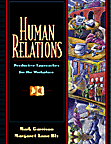 Instructor's
Resource Manual
Instructor's
Resource Manualand Test Item File
 Instructor's
Resource Manual
Instructor's
Resource Manual
and Test Item File
A Guide to Accompany
Human Relations
Productive Approaches
for the Workplace
Mark Garrison
Kentucky State University
Margaret Anne Bly
Edison Community College
Allyn and Bacon
Boston London Toronto Sydney Tokyo Singapore

Preface v
Introduction: Resources for Successful Teaching
1
Chapter Resources
Chapter 1: Effective Human Relations 19
Chapter 2: Communication Processes 31
Chapter 3: Using Communication Skills Effectively 43
Chapter 4: The Self: Preparing the Foundation for Success 53
Chapter 5: The Power of Attitudes and Beliefs 63
Chapter 6: Skill Acquisition and Development 75
Chapter 7: Motivation and Work 85
Chapter 8: Job Satisfaction, involvement, and Performance 97
Chapter 9: The Organization and the Role of the Individual 109
Chapter 10: The Dynamics of Group Membership and Participation 119
Chapter 11: Leadership: Acquiring and Developing Skills for Success 129
Chapter 12: Assessment and Evaluation in the Workplace 143
Chapter 13: Health and Wellness 153
Chapter 14: Problems in the Workplace: Discrimination, Sexual Harassment, Conflict, and Drugs 167
Chapter 15: Work and the Phases of Life 177
Chapter 16: Preparing for the Future 189
Appendix: Understanding Statistics in the Workplace 197
Chapter Test Files
Chapter 1: Effective Human Relations 203
Chapter 2: Communication Processes 215
Chapter 3: Using Communication Skills Effectively 227
Chapter 4: The Self: Preparing the Foundation for Success 239
Chapter 5: The Power of Attitudes and Beliefs 251
Chapter 6: Skill Acquisition and Development 263
Chapter 7: Motivation and Work 275
Chapter 8: Job Satisfaction, involvement, and Performance 287
Chapter 9: The Organization and the Role of the Individual 299
Chapter 10: The Dynamics of Group Membership and Participation 313
Chapter 11: Leadership: Acquiring and Developing Skills for Success 325
Chapter 12: Assessment and Evaluation in the Workplace 339
Chapter 13: Health and Wellness 353
Chapter 14: Problems in the Workplace: Discrimination, Sexual Harassment, Conflict, and Drugs 365
Chapter 15: Work and the Phases of Life 377
Chapter 16: Preparing for the Future 391
Appendix: Understanding Statistics in the Workplace 403
 Preface
Preface
This instructor's resource manual is designed with the needs and concerns of instructors of human relations courses in mind. Our intention in preparing it has been to provide faculty who are using our text, Human Relations: Productive Approaches to the Workplace (Allyn & Bacon), with a guide and resource manual that offers lecture aids, preparation aids, and testing materials. The combination of features provides an opportunity for increased teacher and student success in the classroom and outside the classroom. The items we have included reflect several critical, pedagogical concepts that have guided both the writing of the text and the preparation of these resources. These concepts include what we call "productive thinking," the central role of protocol in guiding human interactions, and effective self-management. Effective self-management primarily includes effective use of time and quality study habits. In this manual, we have many suggestions for the use of the text, the student workbook, CNN resources, and the Internet for making your teaching experience highly successful . In the test item file, we have prepared more than thirteen hundred multiple choice questions. These questions should provide you with a wealth of material for testing and evaluating student performance.
In the introduction to this manual, we describe the many parts of the manual and make recommendations on how you may utilize them to your maximum benefit. We describe the key features of the text, Workbook, and this Instructors' Manual. We will provide a brief explanation of our approach to the manual and test file below.
![]()
This Instructor's Manual accompanies and complements Human Relations: Productive Approaches for the Workplace. We have designed it so that it will provide a powerful and resource-filled teaching guide and serve as a basis for your success in the teaching the course. Our approach has been guided by a view that many who teach a course in human relations are probably overstretched by heavy teaching loads, numerous committee assignments, and a large number of student advisees. Many other instructors may be adjuncts who teach only a few courses and have only a few resources. In either case, the teacher for whom we have designed this manual probably has less time for preparation than ever before. We have developed a number of lecture ideas, classroom activities, and student projects that are closely related to both the text and the student Workbook. This is why we have more objective, multiple choice test questions than any other manual accompanying any human relations text with which we are familiar. Likewise, we saw a need that we, the text authors, should prepare both the Resource Manual and the student Workbook. The materials, activities, and related resources in the text, the Workbook, and the Manual are all closely integrated and designed to take advantage of the key features of the text--productive thinking, protocol, and self-management. These features--and recommendations on how to use them--are discussed in the introduction to this manual.
![]()
We wish you well as you begin your teaching with our text. There are several people who deserve recognition for their significant contributions both to this Manual and to the text it accompanies. A Manual of this quality would be meaningless without a high-quality text. Without the support of the editorial staff at Allyn & Bacon, particularly Mary Beth Finch and Sean Wakely, our efforts to write a book deserving of your time and attention would have been a much greater struggle. We also wish to recognize our families: Bob Turner, and Diane, Erik, Astrid, and Nels Garrison. They have great and sustained patience. Diane was especially helpful in her preparation of many of the elements of this Manual. She collated and imported the many features that Mark and Margaret developed. Her general skills with preparing manuscripts have contributed significantly to the quality of the Manual.
Mark Garrison
Frankfort, Kentucky
Margaret Anne Bly
Fort Myers, Florida